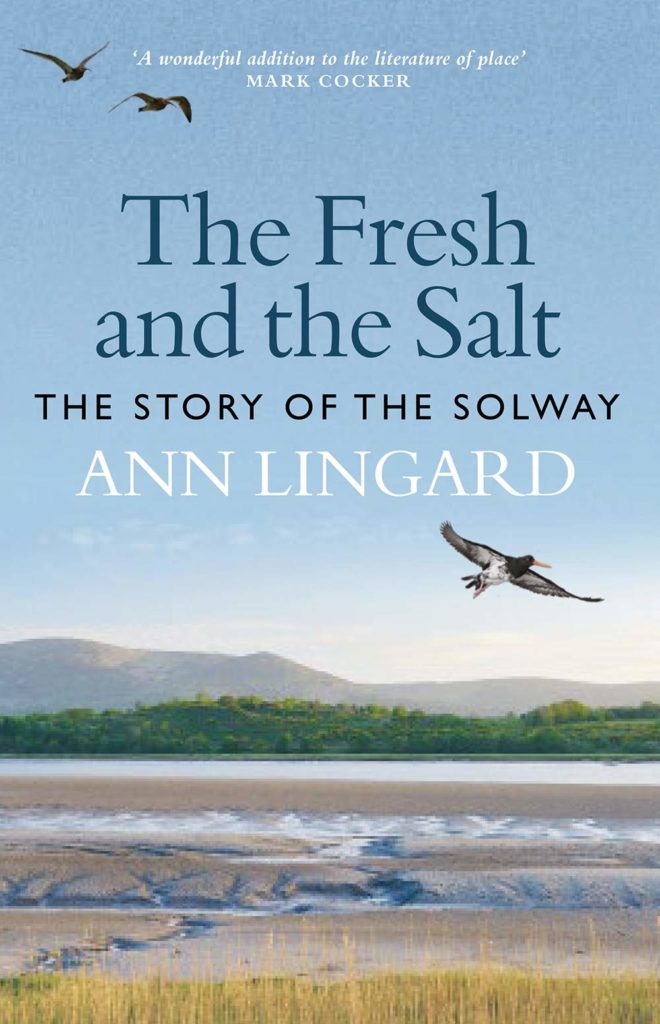In The Fresh and the Salt: The Story of the Solway, published by Birlinn, Ann Lingard explores the crooked finger of water that both unites and divides Scotland and England. Karen Lloyd reviews.

Ann Lingard’s book The Fresh and the Salt opens with a mesmeric description of zooming over the Solway Firth in a gyroplane — something akin to a motorbike with rotor blades. Preparing for the flight at Carlisle Airport, Lingard says: ‘This wasn’t the standard EasyJet briefing, so I listened.’ That idea of listening carefully, the paying of attention, continues throughout the book. And then she’s airborne, and there is the Solway shining beneath, and this altered perspective allows Lingard to see all manner of things, all manner of signs. Here I must admit to being ashamed that as a native Cumbrian, I had not known, for example, that a viaduct once crossed the Solway Firth to Scotland. Lingard is also a committed blogger; my first encounter with her work was a collaborative project with photographer and drone pilot James Smith. The resulting film showed the line of the Solway Junction Railway, long receded into the mire of Bowness Common. Eventually and with its bird’s eye view, the drone crosses the estuary where once the viaduct loomed large in all its doomed engineering.
Lingard is the contemporary equivalent of those great Victorian amateur scientists such as Charles Kingsley — whose interest was brought to bear on subjects as diverse as historic battles, the Pleistocene and peatlands — and Beatrix Potter, who, as well as being the much-loved illustrator of children’s stories, was also a student of mycology, and whose work on the subject was presented to the Linnaean Society of London. Lingard’s is a corresponding fascination with the world around her. Moving from Oxfordshire to north Cumbria after a career in immunology, she studies subjects as diverse as basking sharks, haaf net fishing, dog whelks, industrial archaeology and sandworms. The resulting book is a cabinet of curiosities, an engaging portrait not only of place but of a particular way of seeing; one that sets out to investigate and celebrate much more than that which lies merely upon the surface.
As every turn of the tide presents the liminal world afresh, each chapter unpacks its subjects in a literary topography that takes in the acquaintances and experts that Lingard encounters during her enquiries or rambles along the coast. In ‘Ships and Seaweeds’ there’s a walk with idiosyncratic Cumbrian filmmaker Julia Parks, whose own work is equally rooted in place and community. Lingard describes Park’s film of shipping moving in and out of Workington and Silloth harbours, sped up so that it appears more like animation. What follows from this is a survey of the historic sea roads of this west-coast tidal zone; encompassing Bronze Age log boats, St Ninian’s arrival on the Isle of Whithorn in what is now Dumfries and Galloway, Victorian shipwrecks — testament to the great ages of steam and sail — and Workington’s current role as a hub for everything incoming from chemicals to timber. Elsewhere are other kinds of wrecks; a Lockheed Hudson bomber downed into the Solway in 1942.
Rather than relax into this highly varied subject matter, there’s more a sense of a writer whose ear is constantly attuned to new possibilities, restless for the next thing, because, well, there is just so much to know. If anything, I wanted a bit less; I wanted more of the lyrical writing with which the book opens and to be taken more slowly to fewer places and subjects. But if a book exists as a theatre of ideas, then this one is indeed a thoroughgoing hymn to an adopted homeland — and Lingard feels very much at home.
*
The Fresh and the Salt is out now and available here, via bookshop.org, or direct from your local undefended bookshop.
Karen Lloyd is the award-winning author The Gathering Tide and The Blackbird Diaries. Follow her on Twitter here.